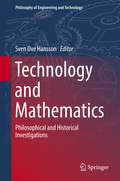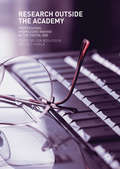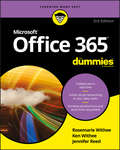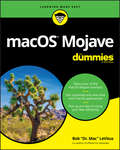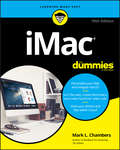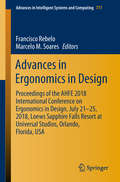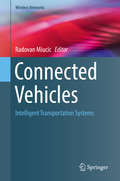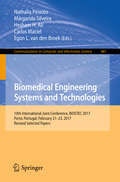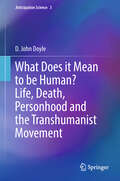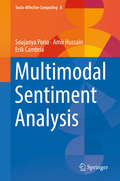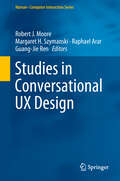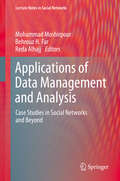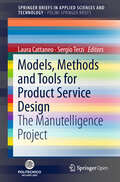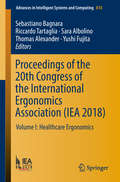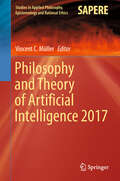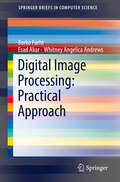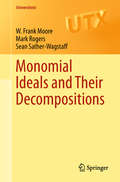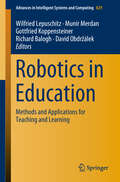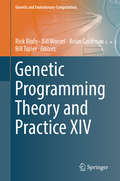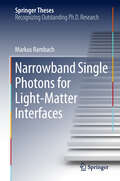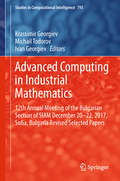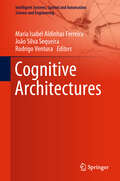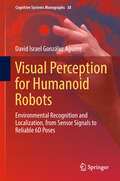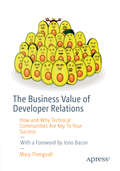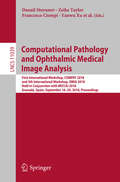- Table View
- List View
Technology and Mathematics: Philosophical and Historical Investigations (Philosophy of Engineering and Technology #30)
by Sven Ove HanssonThis volume is the first extensive study of the historical and philosophical connections between technology and mathematics. Coverage includes the use of mathematics in ancient as well as modern technology, devices and machines for computation, cryptology, mathematics in technological education, the epistemology of computer-mediated proofs, and the relationship between technological and mathematical computability. The book also examines the work of such historical figures as Gottfried Wilhelm Leibniz, Charles Babbage, Ada Lovelace, and Alan Turing.
Research Outside The Academy: Professional Knowledge-making In The Digital Age
by Isto Huvila Lisa BörjessonThis book analyses the practical, information-related dimensions of professional knowledge making and communication in extra-academic organisations. It treats the sites where research takes place and where knowledge is created outside academia in the light, among other things, of new digital resources. It provides valuable insight into the practices through which extra-academic research data and results are produced and made available and the settings in which this takes place. With case studies of knowledge-making in government organizations and state research institutes, as well as in cultural and heritage institutions, this book broadens the perspective on knowledge sharing, communication and publication, and how knowing changes as a result of the professional knowledge-making practices in the digital age.Research outside the Academy is ideal for students at all levels looking for an introduction to the topic of research and knowledge-making in society. Moreover, researchers and professionals in the fields of library and information science and science and technology studies will find the book to be adding to previous understandings of scholarly documentation and communication.
Office 365 For Dummies
by Rosemarie Withee Ken Withee Jennifer ReedEverything you need to get productive in the Cloud with Office 365 With 70 million users worldwide, Microsoft Office 365 combines the familiar Office desktop suite with cloud-based versions of Microsoft’s next-generation communications and collaboration services. It offers many benefits including security, reliability, compatibility with other products, over-the-air updates in the cloud that don't require anything from the user, single sign on for access to everything right away, and so much more. Office 365 For Dummies offers a basic overview of cloud computing and goes on to cover Microsoft cloud solutions and the Office 365 product in a language you can understand. This includes an introduction to each component which leads into topics around using each feature in each application. Get up to speed on instant messaging Use audio, video, and web conferencing Get seamless access to the Office suite with Office Web apps Access information anywhere, anytime Office 365 is the key to office productivity — and now you can put it to use for you!
macOS Mojave For Dummies
by Bob LeVitusPro tips for macOS from “Dr. Mac” Your shiny new iMac or trusty old MacBook both rely on macOS to help you get things done. It helps to have an equally reliable guidebook to steer you through the tasks and steps that make macOS run efficiently. This fun and friendly guide provides the direction you need to easily navigate macOS. Longtime expert Bob "Dr. Mac" LeVitus shares his years of experience to help you better understand macOS and make it a timesaving tool in your life. Take a tour of the macOS interface Get organized and save time with macOS applications Get pro tips on speeding up your Mac Back up your data with ease Covering the fundamentals of the OS and offering insight into the most common functions of macOS, this is indispensable reading for new or inexperienced macOS users.
iMac For Dummies
by Mark L. ChambersThe perfect companion for iMac users You've got a great iMac, but now it's time to take things to the next level. This easy-to-use guide shows you how to do stuff like setting up and configuring your iMac along with fun stuff like using the Photos, Messages, and iMovie apps. You'll also discover how to get down to business with productivity apps like Numbers, Pages, and Keynote. Finally, you'll find help on how to sync everything to iCloud and stay organized with Family Sharing. Personalize your iMac and find your way around macOS X Surf the web, send Reminders, and make FaceTime video calls Store your photos and files with iCloud Discover tricks to become more efficient iMac newbies won’t want to be without this easy-to-follow companion guide!
Advances in Ergonomics in Design: Proceedings of the AHFE 2018 International Conference on Ergonomics in Design, July 21-25, 2018, Loews Sapphire Falls Resort at Universal Studios, Orlando, Florida, USA (Advances in Intelligent Systems and Computing #777)
by Marcelo M. Soares Francisco RebeloThis book provides readers with a timely snapshot of ergonomics research and methods applied to the design, development and prototyping – as well as the evaluation, training and manufacturing – of products, systems and services. Combining theoretical contributions, case studies, and reports on technical interventions, it covers a wide range of topics in ergonomic design including: ecological design; educational and game design; cultural and ethical aspects in design; user research and human–computer interaction in design; as well as design for accessibility and extreme environments, and many others. The book particularly focuses on new technologies such as virtual reality, state-of-the-art methodologies in information design, and human–computer interfaces. Based on the AHFE 2018 International Conference on Ergonomics in Design, held on July 21–25, 2018, in Orlando, Florida, USA, the book offers a timely guide for both researchers and design practitioners, including industrial designers, human–computer interaction and user experience researchers, production engineers and applied psychologists.
Connected Vehicles: Intelligent Transportation Systems (Wireless Networks)
by Radovan MiucicThis book introduces concepts and technologies of Intelligent Transportation Systems (ITS). It describes state of the art safety communication protocol called Dedicated Short Range Communication (DSRC), currently being considered for adoption by the USDOT and automotive industry in the US. However, the principles of this book are applicable even if the underlying physical layer protocol of V2X changes in the future, e.g. V2X changes from DSRC to cellular-based connectivity. Fundamental ITS concepts include topics like global positioning system; Vehicle to Vehicle (V2V), Vehicle to Pedestrian (V2P), and Vehicle to Infrastructure (V2I) communications; human-machine interface; and security and privacy. Fundamental concepts are sometimes followed by the real-life test experimental results (such as in V2P Chapter) and description of the performance metrics used to evaluate the results. This book also describes equations and math used in the development of the individual parts of the system. This book surveys current and previous publications for trending research in the ITS domain. It also covers state of the art standards that are in place for the DSRC in the US, starting from the application layer defined in SAE J2735 all the way to physical layer defined in IEEE 802.11. The authors provide a detailed discussion on what is needed to extend the current standards to accommodate future needs of the vehicle communications, such as needs for future autonomous vehicles. Programs and code examples accompany appropriate chapters, for example, after describing remote vehicle target classification function a pseudo code and description is provided. In addition, the book discusses current topics of the technology such as spectrum sharing, simulation, security, and privacy. The intended audience for this book includes engineering graduate students, automotive professionals/engineers, researchers and technology enthusiasts.
Biomedical Engineering Systems and Technologies: 10th International Joint Conference, Biostec 2017, Porto, Portugal, February 21-23, 2017, Revised Selected Papers (Communications In Computer And Information Science #881)
by Egon L. van den Broek Carlos Maciel Hesham H. Ali Margarida Silveira Nathalia PeixotoThis book constitutes the thoroughly refereed post-conference proceedings of the 10th International Joint Conference on Biomedical Engineering Systems and Technologies, BIOSTEC 2017, held in Porto, Portugal, in February 2017.The 20 revised full papers presented were carefully reviewed and selected from a total of 297 submissions. The papers are organized in topical sections on biomedical electronics and devices; bioimaging; bioinformatics models, methods and algorithms; bio-inspired systems and signal processing; and health informatics.
What Does it Mean to be Human? Life, Death, Personhood and the Transhumanist Movement (Anticipation Science #3)
by D. John DoyleThis book is a critical examination of the philosophical and moral issues in relation to human enhancement and the various related medical developments that are now rapidly moving from the laboratory into the clinical realm. In the book, the author critically examines technologies such as genetic engineering, neural implants, pharmacologic enhancement, and cryonic suspension from transhumanist and bioconservative positions, focusing primarily on moral issues and what it means to be a human in a setting where technological interventions sometimes impact strongly on our humanity. The author also introduces the notion that death is a process rather than an event, as well as identifies philosophical and clinical limitations in the contemporary determination of brain death as a precursor to organ procurement for transplantation. The discussion on what exactly it means to be dead is later applied to explore philosophical and clinical issues germane to the cryonics movement. Written by a physician/ scientist and heavily referenced to the peer-reviewed medical and scientific literature, the book is aimed at advanced students and academics but should be readable by any intelligent reader willing to carry out some side-reading. No prior knowledge of moral philosophy is assumed, as the various key approaches to moral philosophy are outlined early in the book.
Multimodal Sentiment Analysis (Socio-Affective Computing #8)
by Soujanya Poria Amir Hussain Erik CambriaThis latest volume in the series, Socio-Affective Computing, presents a set of novel approaches to analyze opinionated videos and to extract sentiments and emotions. Textual sentiment analysis framework as discussed in this book contains a novel way of doing sentiment analysis by merging linguistics with machine learning. Fusing textual information with audio and visual cues is found to be extremely useful which improves text, audio and visual based unimodal sentiment analyzer. This volume covers the three main topics of: textual preprocessing and sentiment analysis methods; frameworks to process audio and visual data; and methods of textual, audio and visual features fusion. The inclusion of key visualization and case studies will enable readers to understand better these approaches. Aimed at the Natural Language Processing, Affective Computing and Artificial Intelligence audiences, this comprehensive volume will appeal to a wide readership and will help readers to understand key details on multimodal sentiment analysis.
Studies in Conversational UX Design (Human–Computer Interaction Series)
by Guang-Jie Ren Raphael Arar Margaret H. Szymanski Robert J. MooreAs voice interfaces and virtual assistants have moved out of the industry research labs and into the pockets, desktops and living rooms of the general public, a demand for a new kind of user experience (UX) design is emerging. Although the people are becoming familiar with Siri, Alexa, Cortana and others, their user experience is still characterized by short, command- or query-oriented exchanges, rather than longer, conversational ones. Limitations of the microphone and natural language processing technologies are only part of the problem. Current conventions of UX design apply mostly to visual user interfaces, such as web or mobile; they are less useful for deciding how to organize utterances, by the user and the virtual agent, into sequences that work like those of natural human conversation. This edited book explores the intersection of UX design, of both text- or voice-based virtual agents, and the analysis of naturally occurring human conversation (e.g., the Conversation Analysis, Discourse Analysis and Interactional Sociolinguistics literatures). It contains contributions from researchers, from academia and industry, with varied backgrounds working in the area of human-computer interaction. Each chapter explores some aspect of conversational UX design. Some describe the design challenges faced in creating a particular virtual agent. Others discuss how the findings from the literatures of the social sciences can inform a new kind of UX design that starts with conversation.
Applications of Data Management and Analysis: Case Studies in Social Networks and Beyond (Studies in Big Data #27)
by Reda Alhajj Behrouz H. Far Mohammad MoshirpourThis book addresses and examines the impacts of applications and services for data management and analysis, such as infrastructure, platforms, software, and business processes, on both academia and industry. The chapters cover effective approaches in dealing with the inherent complexity and increasing demands of big data management from an applications perspective.Various case studies included have been reported by data analysis experts who work closely with their clients in such fields as education, banking, and telecommunications. Understanding how data management has been adapted to these applications will help students, instructors and professionals in the field. Application areas also include the fields of social network analysis, bioinformatics, and the oil and gas industries.
Models, Methods and Tools for Product Service Design: The Manutelligence Project (SpringerBriefs in Applied Sciences and Technology)
by Sergio Terzi Laura CattaneoThis open access book summarizes research being pursued within the Manutelligence project, the goal of which is to help enterprises develop smart, social and flexible products with high value added services. Manutelligence has improved Product and Service Design by developing suitable models and methods, and connecting them through a modular, collaborative and secure ICT Platform. The use of real data collected in real time by Internet of Things (IoT) technologies underpins the design of product-service systems and makes it possible to monitor them throughout their life cycle. Available data allows costs and sustainability issues to be more accurately measured and simulated in the form of Life Cycle Cost (LCC) and Life Cycle Assessment (LCA). Analysing data from IoT systems and sharing LCC and LCA information via the ICT Platform can help to accelerate the design of product-service systems, reduce costs and better understand customer needs. Industrial partners involved in Manutelligence provide a clear overview of the project’s outcomes, and demonstrate how its technological solutions can be used to improve the design of product-service systems and the management of product-service life cycles.
Proceedings of the 20th Congress of the International Ergonomics Association: Volume I: Healthcare Ergonomics (Advances in Intelligent Systems and Computing #818)
by Sebastiano Bagnara Riccardo Tartaglia Sara Albolino Thomas Alexander Yushi FujitaThis book presents the proceedings of the 20th Congress of the International Ergonomics Association (IEA 2018), held on August 26-30, 2018, in Florence, Italy. By highlighting the latest theories and models, as well as cutting-edge technologies and applications, and by combining findings from a range of disciplines including engineering, design, robotics, healthcare, management, computer science, human biology and behavioral science, it provides researchers and practitioners alike with a comprehensive, timely guide on human factors and ergonomics. It also offers an excellent source of innovative ideas to stimulate future discussions and developments aimed at applying knowledge and techniques to optimize system performance, while at the same time promoting the health, safety and wellbeing of individuals. The proceedings include papers from researchers and practitioners, scientists and physicians, institutional leaders, managers and policy makers that contribute to constructing the Human Factors and Ergonomics approach across a variety of methodologies, domains and productive sectors. This volume includes papers addressing Healthcare Ergonomics.
Philosophy and Theory of Artificial Intelligence 2017 (Studies in Applied Philosophy, Epistemology and Rational Ethics #44)
by Vincent C. MüllerThis book reports on the results of the third edition of the premier conference in the field of philosophy of artificial intelligence, PT-AI 2017, held on November 4 - 5, 2017 at the University of Leeds, UK. It covers: advanced knowledge on key AI concepts, including complexity, computation, creativity, embodiment, representation and superintelligence; cutting-edge ethical issues, such as the AI impact on human dignity and society, responsibilities and rights of machines, as well as AI threats to humanity and AI safety; and cutting-edge developments in techniques to achieve AI, including machine learning, neural networks, dynamical systems. The book also discusses important applications of AI, including big data analytics, expert systems, cognitive architectures, and robotics. It offers a timely, yet very comprehensive snapshot of what is going on in the field of AI, especially at the interfaces between philosophy, cognitive science, ethics and computing.
Digital Image Processing: Practical Approach (SpringerBriefs in Computer Science)
by Whitney Angelica Andrews Esad Akar Borko FurhtThe SpringerBrief covers fundamentals of digital image processing including image concept, image file formats, creating user interfaces and many practical examples of processing images using C++ and Java. These practical examples include among other creating image histograms, performing lossless image compression, detecting change in colors, similarity-based image retrieval and others. All practical examples are accompanied with an explanation how to create programs and the obtained results. This SpringerBrief can be very useful for the undergraduate courses on image processing, providing students with the basic tools in image analysis and processing. Practitioners and researchers working in this field will also find this research useful.
Monomial Ideals and Their Decompositions (Universitext)
by W. Frank Moore Mark Rogers Sean Sather-WagstaffThis textbook on combinatorial commutative algebra focuses on properties of monomial ideals in polynomial rings and their connections with other areas of mathematics such as combinatorics, electrical engineering, topology, geometry, and homological algebra. Aimed toward advanced undergraduate students and graduate students who have taken a basic course in abstract algebra that includes polynomial rings and ideals, this book serves as a core text for a course in combinatorial commutative algebra or as preparation for more advanced courses in the area. The text contains over 600 exercises to provide readers with a hands-on experience working with the material; the exercises include computations of specific examples and proofs of general results. Readers will receive a firsthand introduction to the computer algebra system Macaulay2 with tutorials and exercises for most sections of the text, preparing them for significant computational work in the area. Connections to non-monomial areas of abstract algebra, electrical engineering, combinatorics and other areas of mathematics are provided which give the reader a sense of how these ideas reach into other areas.
Robotics in Education: Latest Results And Developments (Advances In Intelligent Systems and Computing #630)
by David Obdržálek Richard Balogh Gottfried Koppensteiner Munir Merdan Wilfried LepuschitzThis proceedings volume comprises the latest achievements in research and development in educational robotics presented at the 9th International Conference on Robotics in Education (RiE) held in Qawra, St. Paul's Bay, Malta, during April 18-20, 2018. Researchers and educators will find valuable methodologies and tools for robotics in education that encourage learning in the fields of science, technology, engineering, arts and mathematics (STEAM) through the design, creation and programming of tangible artifacts for creating personally meaningful objects and addressing real-world societal needs. This also involves the introduction of technologies ranging from robotics platforms to programming environments and languages. Extensive evaluation results are presented that highlight the impact of robotics on the students’ interests and competence development. The presented approaches cover the whole educative range from elementary school to the university level in both formal as well as informal settings.
Genetic Programming Theory and Practice XIV (Genetic and Evolutionary Computation)
by Rick Riolo Bill Worzel Brian Goldman Bill TozierThese contributions, written by the foremost international researchers and practitioners of Genetic Programming (GP), explore the synergy between theoretical and empirical results on real-world problems, producing a comprehensive view of the state of the art in GP. Chapters in this volume include: Similarity-based Analysis of Population Dynamics in GP Performing Symbolic RegressionHybrid Structural and Behavioral Diversity Methods in GPMulti-Population Competitive Coevolution for Anticipation of Tax EvasionEvolving Artificial General Intelligence for Video Game ControllersA Detailed Analysis of a PushGP RunLinear Genomes for Structured ProgramsNeutrality, Robustness, and Evolvability in GPLocal Search in GPPRETSL: Distributed Probabilistic Rule Evolution for Time-Series ClassificationRelational Structure in Program Synthesis Problems with Analogical ReasoningAn Evolutionary Algorithm for Big Data Multi-Class Classification ProblemsA Generic Framework for Building Dispersion Operators in the Semantic SpaceAssisting Asset Model Development with Evolutionary AugmentationBuilding Blocks of Machine Learning Pipelines for Initialization of a Data Science Automation Tool Readers will discover large-scale, real-world applications of GP to a variety of problem domains via in-depth presentations of the latest and most significant results.
Narrowband Single Photons for Light-Matter Interfaces (Springer Theses)
by Markus RambachThis book provides a step-by-step guide on how to construct a narrowband single photon source for the integration with atom-based memory systems. It combines the necessary theoretical background with crucial experimental methods and characterisations to form a complete handbook for readers at all academic levels. The future implementation of large quantum networks will require the hybridisation of photonic qubits for communication with quantum memories in the context of information storage. Such an interface requires carefully tailored single photons to ensure compatibility with the chosen memory. The source itself is remarkable for a number of reasons, including being the spectrally narrowest and brightest source of its kind; in addition, it offers a novel technique for frequency stabilisation in an optical cavity, together with exceptional portability. Starting with a thorough analysis of the current literature, this book derives the essential parameters needed to design the source, describes its individual components in detail, and closes with the characterisation of a single photon source.
Advanced Computing in Industrial Mathematics: 11th Annual Meeting Of The Bulgarian Section Of Siam December 20-22, 2016, Sofia, Bulgaria. Revised Selected Papers (Studies in Computational Intelligence #728)
by Ivan Georgiev Michail Todorov Krassimir GeorgievThis book gathers the peer-reviewed proceedings of the 12th Annual Meeting of the Bulgarian Section of the Society for Industrial and Applied Mathematics, BGSIAM’17, held in Sofia, Bulgaria, in December 2017. The general theme of BGSIAM’17 was industrial and applied mathematics, with a particular focus on: high-performance computing, numerical methods and algorithms, analysis of partial differential equations and their applications, mathematical biology, control and uncertain systems, stochastic models, molecular dynamics, neural networks, genetic algorithms, metaheuristics for optimization problems, generalized nets, and Big Data.
Cognitive Architectures (Intelligent Systems, Control and Automation: Science and Engineering #94)
by Rodrigo Ventura João Silva Sequeira Maria Isabel Aldinhas FerreiraThis book provides an integrated framework for natural and artificial cognition by highlighting the fundamental role played by the cognitive architecture in the dialectics with the surrounding environment and consequently in the definition of a particular meaningful world.This book is also about embodied and non-embodied artificial systems, cognitive architectures that are human constructs, meant to be able to populate the human world, capable of identifying different life contexts and replicating human patterns of behavior capable of acting according to human values and conventions, systems that perform tasks in a human-like way. By identifying the essential phenomena at the core of all forms of cognition, the book addresses the topic of design of artificial cognitive architectures in the domains of robotics and artificial life. Moving from mere bio-inspired design methodology it aims to open a pathway to semiotically determined design.
Visual Perception for Humanoid Robots: Environmental Recognition and Localization, from Sensor Signals to Reliable 6D Poses (Cognitive Systems Monographs #38)
by David Israel González AguirreThis book provides an overview of model-based environmental visual perception for humanoid robots. The visual perception of a humanoid robot creates a bidirectional bridge connecting sensor signals with internal representations of environmental objects. The objective of such perception systems is to answer two fundamental questions: What & where is it? To answer these questions using a sensor-to-representation bridge, coordinated processes are conducted to extract and exploit cues matching robot’s mental representations to physical entities. These include sensor & actuator modeling, calibration, filtering, and feature extraction for state estimation. This book discusses the following topics in depth: • Active Sensing: Robust probabilistic methods for optimal, high dynamic range image acquisition are suitable for use with inexpensive cameras. This enables ideal sensing in arbitrary environmental conditions encountered in human-centric spaces. The book quantitatively shows the importance of equipping robots with dependable visual sensing. • Feature Extraction & Recognition: Parameter-free, edge extraction methods based on structural graphs enable the representation of geometric primitives effectively and efficiently. This is done by eccentricity segmentation providing excellent recognition even on noisy & low-resolution images. Stereoscopic vision, Euclidean metric and graph-shape descriptors are shown to be powerful mechanisms for difficult recognition tasks. • Global Self-Localization & Depth Uncertainty Learning: Simultaneous feature matching for global localization and 6D self-pose estimation are addressed by a novel geometric and probabilistic concept using intersection of Gaussian spheres. The path from intuition to the closed-form optimal solution determining the robot location is described, including a supervised learning method for uncertainty depth modeling based on extensive ground-truth training data from a motion capture system.The methods and experiments are presented in self-contained chapters with comparisons and the state of the art. The algorithms were implemented and empirically evaluated on two humanoid robots: ARMAR III-A & B. The excellent robustness, performance and derived results received an award at the IEEE conference on humanoid robots and the contributions have been utilized for numerous visual manipulation tasks with demonstration at distinguished venues such as ICRA, CeBIT, IAS, and Automatica.
The Business Value of Developer Relations: How and Why Technical Communities Are Key To Your Success
by Mary ThengvallDiscover the true value of Developer Relations as you learn to build and maintain positive relationships with your developer community. Use the principles laid out in this book to walk through your company goals and discover how you can formulate a plan tailored to your specific needs.First you will understand the value of a technical community: why you need to foster a community and how to do it. Then you will learn how to be involved in community building on a daily basis: finding the right audience, walking the tightrope between representing the company and building a personal brand, in-person events, and more.Featuring interviews with Developer Relations professionals from many successful companies including Red Hat, Google, Chef, Docker, Mozilla, SparkPost, Heroku, Twilio, CoreOS, and more, and with a foreword by Jono Bacon, The Business Value of Developer Relations is the perfect book for anyone who is working in the tech industry and wants to understand where DevRel is now and how to get involved. Don’t get left behind – join the community today. What You’ll Learn Define community and sell community to your company Find, build, and engage with the community Determine how and when to hire community managersBuild your own personal brandWho This Book Is For Any business leaders/owners/stakeholders in the tech industry, tech evangelists, community managers or developer advocates.
Computational Pathology and Ophthalmic Medical Image Analysis: First International Workshop, COMPAY 2018, and 5th International Workshop, OMIA 2018, Held in Conjunction with MICCAI 2018, Granada, Spain, September 16 - 20, 2018, Proceedings (Lecture Notes in Computer Science #11039)
by Danail Stoyanov Zeike Taylor Francesco Ciompi Yanwu Xu Anne Martel Lena Maier-Hein Nasir Rajpoot Jeroen van der Laak Mitko Veta Stephen McKenna David Snead Emanuele Trucco Mona K. Garvin Xin Jan Chen Hrvoje BogunovicThis book constitutes the refereed joint proceedings of the First International Workshop on Computational Pathology, COMPAY 2018, and the 5th International Workshop on Ophthalmic Medical Image Analysis, OMIA 2018, held in conjunction with the 21st International Conference on Medical Imaging and Computer-Assisted Intervention, MICCAI 2018, in Granada, Spain, in September 2018. The 19 full papers (out of 25 submissions) presented at COMPAY 2018 and the 21 full papers (out of 31 submissions) presented at OMIA 2018 were carefully reviewed and selected. The COMPAY papers focus on artificial intelligence and deep learning. The OMIA papers cover various topics in the field of ophthalmic image analysis.
